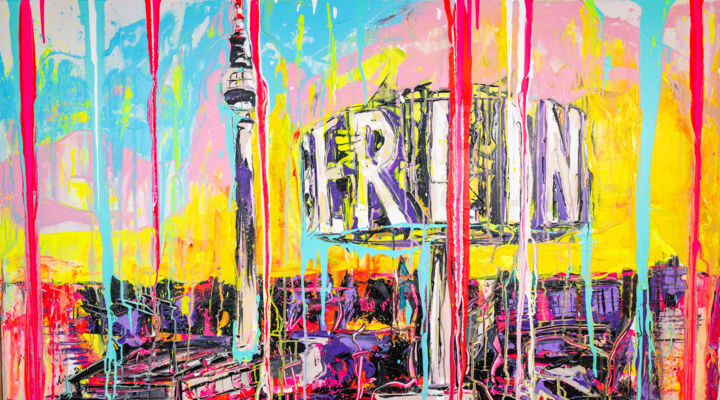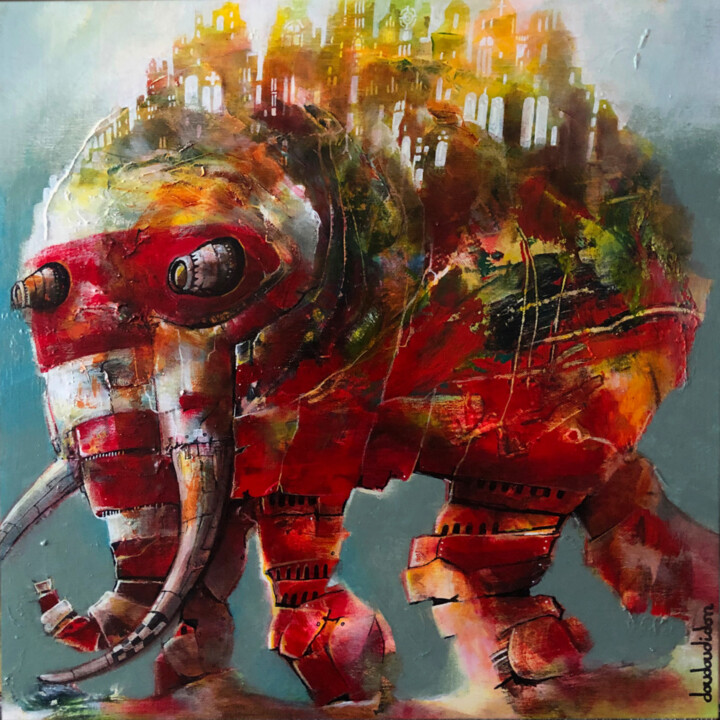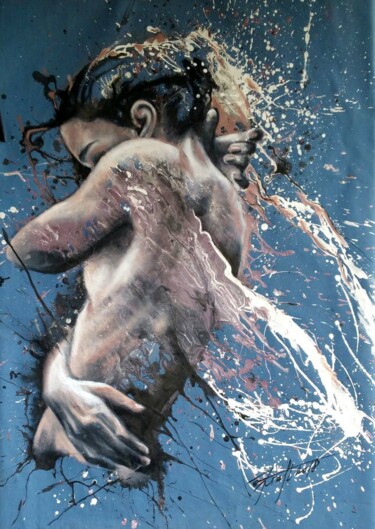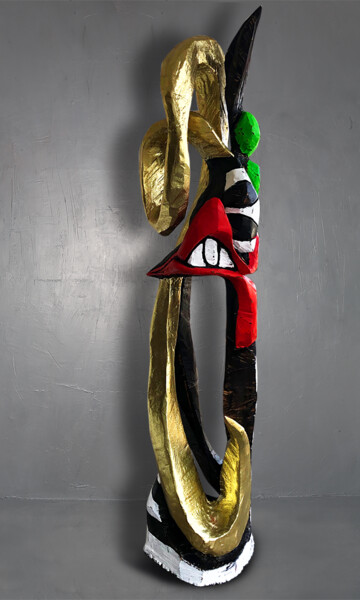 Ilgvars Zalans, Berlin Story, 2021. Oil on canvas, 50 x 50 cm.
Ilgvars Zalans, Berlin Story, 2021. Oil on canvas, 50 x 50 cm.
Berlin graffiti compared with Gauguin, Munch, Goya and Zurbarán
There are different ways to approach the telling of art history, some pursuing the purpose of illustrating, for example, the figurative tradition of a specific country. In this sense, as the major art historians teach, I could put in writing the creative impetus of Germany, chronologically collecting examples ranging from prehistory to the present day. This narrative, of a rather "classical" setting, turns out to be, oftentimes, uncreative and monotonous, as it focuses, in a rather "static" manner, on the temporal succession of masterpieces, masters and artistic currents, avoiding, oftentimes, more interesting terms of comparison, aimed at directly comparing even visions from, to say the least, contrasting eras. A similar but more circumscribed approach, and consequently more capable of accommodating reflections "out of the chorus" within it, turns out to be that which is devoted to the analysis of a single historical period of a national art, a subject that turns out to be more open to "dialogue" with earlier or later epochs. The mode I have chosen to talk about the aforementioned German art, gathers, on the other hand, in an even more "intimate" and limited context, such as the city of Berlin, a "destination" that allowed me to focus all my attention on three masters of contemporary street art, whom I was able to "compare," in a rather daring, original and innovative way, with Gauguin, Munch, Goya, and Zurbarán. Assuming that Berlin, since the era after the fall of the wall, has become one of the most important capitals of world street art, it is important to highlight how, within the most disparate neighborhoods of the German city, the works of famous artists, such as, to give an example, Herakut, Rosco, Dr. Drax, Pase, Akte One, Kobe, Os Gemeos, BLU and ROA, multiply. About the latter three in particular, I take this opportunity to begin my story by starting with Os Gemeos, who, as the translation of their own Portuguese nickname anticipates, are two Brazilian twin brothers, whose very strong blood bond has generated a valuable artistic collaboration conceived and realized exclusively by four hands. How to spot the duo's works if, having happened upon the right place, you find yourself happily strolling down the street with your pooch? Their work, which they themselves identify as graffiti writing rather than street art, is highly recognizable! In fact, the first thing that comes to mind when we think of Os Gemeos is the use of extremely intense colors, which, explicated mainly in shades of yellow, tend to tint the faces of their bizarre characters, whose skin voluntarily alludes to the Brazilian sun. In addition to the representative connection to the motherland, the twins' work deals with a multitude of topics, which range from love to sex, from dreams to anarchy, from innocence to lawlessness. Returning to the stylistic elements, they are well exemplified by The yellow man, a brightly colored mural presented by the strange character, who, perhaps a distant relative of Frankenstein, we find adorning the entire wall of a house in the Kreuzberg district, who has become a celebrity for his small, fixed-eyed stare, contained in an "anomalous" "triangular" head, supported by sloping shoulders, culminating in extremely slender limbs. In this context it is worth noting how, although most of the brothers' works were conceived in yellow, the face of the Kreuzberg "monster" was initially green, as it was only after weathering that the work was brought, almost paradoxically, to the favored color of the aforementioned artists. In the history of art, however, the narrative about yellow, or yellow-green, faces is long, so that well-known examples of what has just been stated can be found in Gauguin's Yellow Christ (1889), Much's Scream (1893), and Van Gogh's Portrait with Bandaged Ear (1889).
 Laetitia Infantino, Berlin night, 2021. Acrylic / charcoal on linen canvas, 33 x 46 cm.
Laetitia Infantino, Berlin night, 2021. Acrylic / charcoal on linen canvas, 33 x 46 cm.
Consequently, once again, the greatest masters of the past had predicted, in part, the future of art, so much so that their "previews" continue in the story about BLU, "Italian Banksy," who, without yet having revealed his identity, created, precisely in 2007, a large mural located at the western end of the Oberbaum Bridge in Kreuzberg, having as its subject a monster, which, formed of many small pink human beings, is intent on eating a strangely white one. However, the scene does not show the moment when the small being is devoured, but the instant in which it gradually approaches the giant's gaping mouth, a detail that gives the work a state of perpetual suspension. The interpretation of the aforementioned monster, titled The pink man, could be as follows: many little men unite, generating a giant capable of harming the weakest. This mode of devious association of the human being has, alas, materialized all too often throughout our history, which, in this case, speaking of Berlin, inexorably reminds us of the havoc wrought by Nazism. Returning to the "seers" of the past, the aforementioned cannibalism of BLU, although mainly related to purely mythological or fanciful themes, can be found, for example, in Goya's Saturn Devouring His Children (1819-1823) and Dali's Autumnal Cannibalism (1936). Finally, ROA, Street artist, also a super fan of anonymity, has created in Berlin, precisely in Oranienstrasse, a gigantic still life, having as its subject a dead rabbit, a stork and a deer, "hanging" via a wire from the roof of the facade of the building that houses them, at the lower end of which rests serenely a ram, probably unaware of its imminent and similar demise. The treatment of such a theme, classic in art history to say the least, should not surprise us, as the Ghent (Belgium) street artist is known for depicting animals with a net biological precision, whom, whether living or dead, serve as a pretext for talking about the transience of our existence. In addition to classic still lifes of animals, however, the glorious past of art history also provides us with examples of literally skinned carcasses, such as those featured in Panayòtis Tetsis' Butcher (1955-56) or, even, living skeletons, similar to the horse in the Triumph of Death in the Regional Gallery of Palazzo Abatellis (Palermo, Italy). In conclusion, the tale of Berlin's murals continues, enriched, this time, by the viewpoints of Artmajeur artists, such as that of Markus, Loic Tarin and Joe Baxxter.
 Antoni Dragan, Sunset in Berlin, 2021. Acrylic on canvas, 90 x 160 cm.
Antoni Dragan, Sunset in Berlin, 2021. Acrylic on canvas, 90 x 160 cm.
 Markus, *Astronaut*, 2022. Acrylic on Canvas, 150 x 114 cm.
Markus, *Astronaut*, 2022. Acrylic on Canvas, 150 x 114 cm.
Markus: *Astronaut*
Strolling back through Kreuzberg, a large Berlin neighborhood where predominantly students, artists and a large Turkish community live, you are highly likely to come across a monumental work of art, among the most iconic in the city: the Astronaut Cosmonaut mural, created, in 2007, by French artist Viktor Ash, known simply as Ash. The work, which used the walls of a vast white building as its support, depicts a floating astronaut, whose figure, according to the Street artists' own statements, takes direct cues from the space race coveted by the USSR and the US during the infamous Cold War. This main source of inspiration pursues the purpose of accompanying the viewer toward a voluntary escape from historical or media reality, in order to find solace in a more reassuringly intimate dimension. In addition to the above, Ash revealed that Astronaut Cosmonaut's desire for escapism also took its cues from both Space Oddity and David Bowie's Ashes to Ashes, songs that, when played together, tell the story of an astronaut, who, first gets lost in space and, later, only discovers himself in the grip of trippy hallucinations. Into this context fits well the protagonist of *Astronaut*, who, immersed in a "psychedelic" background, is perhaps lost in a colorful mental journey, probably the result of one of Dr. Hoffman's most talked about inventions.
 Loic Tarin, Of tiles and temples, 2021. Painting, Acrylic / spray paint / pencil on linen canvas, 50 x 50 cm.
Loic Tarin, Of tiles and temples, 2021. Painting, Acrylic / spray paint / pencil on linen canvas, 50 x 50 cm.
Loic Tarin: Of tiles and temples
Another undisputed protagonist of Berlin's walls is Elephant Playing with a Balloon, a mural by German artist Jadore Tonk, aka S.Y.R.U.S, who, in order to bring his iconic project to life, "daubed" the rear fire wall of a building located at number seven Wilhelmstrasse (Berlin). Therefore, we find ourselves again in the creative Kreuzberg district, this time, however, facing a more "joyful" turquoise background, against which stands the heavy figure of an ornament-covered elephant, which is "surmounted" by the slight figure of a globe-shaped balloon, which is withheld in the wind by the animal's own trunk. The meaning of the work is probably to be found in the themes most dear to the artist, such as the opposition between freedom and oppression, individualism and collectivism, etc. The right choice between such tendencies, that is, the one aimed at the realization of the good, is created, according to Tonk, through the interaction of spirituality, dream, reality and vision, "labile" dimensions like the lightness of a balloon. In comparison, the artist's painting of Artmajeur seems "less positivistic," suggesting, instead, a change in the attitude of the animal, which, in this case, has probably taken on the burdens of the world, as it is intent on carrying on its shoulders the heavy marks of a civilization, surely not so easily removed by the wind.
 Joe Baxxter, Angel thief deluxe, 2022. Printmaking, digital painting / digital print / screenprinting on aluminium, 80 x 80 cm.
Joe Baxxter, Angel thief deluxe, 2022. Printmaking, digital painting / digital print / screenprinting on aluminium, 80 x 80 cm.
Joe Baxxter: Angel thief deluxe
The attractive protagonist of Angel thief deluxe, immortalized by Baxxter's digital painting, brings to mind a masterpiece of Berlin street art, for, putting aside the woman's money, glitz and elegance, elements that come to life within an abstract background littered with luxury brands, the effigy wears a balaclava, a pair of wings and a halo. Perhaps, she too has passed on to a better life concealing her beautiful face, just as the fate of the two protagonists of Brothers, a now "defunct" mural, which had been created by Blu, circa 2007, at Cuvrystrasse (Berlin). The Italian artist's work, which depicted two characters intent on removing each other's balaclavas, while their free hands implied the signs of West and East, clearly alluding to the former division of the wall, in fact suffered "artistic euthanasia" in 2014, probably inflicted on it by Blu himself. The form taken by the death in Brothers is simple: the artist covered the mural totally in black, censoring it in order to oppose a speculative redevelopment plan designed to raise prices in the area precisely because of the work's presence. If this artistic loss makes us not a little sorry, strong is the sense of redemption fostered by an art, which, unfortunately now at the mercy of auction houses and museums, was born primarily to oppose the upper echelons of our system.


 Olimpia Gaia Martinelli
Olimpia Gaia Martinelli























